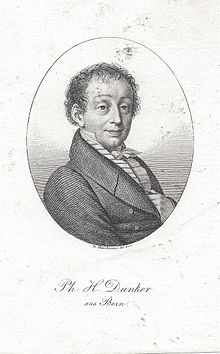Philipp Heinrich Dunker
Philipp Heinrich Dunker (also: Duncker ; * August 7, 1779 in Bern ; † May 3, 1836 in Nuremberg ) was a Swiss - German landscape painter and etcher , who mainly worked in Nuremberg.
Life
Philipp Heinrich Dunker was the fourth son of the Swiss-German artist Balthasar Anton Dunker (1746–1807) and his wife Johanna Franziska Fahrni from Eriz . The godparents were visiting Philipp Hackert and Heinrich Rieter , whose first names formed the two first names of the person to be baptized. The artistic training took place with the father. In 1800 he moved to Nuremberg and worked for the publisher Johann Friedrich Frauenholz , in whose house he was accepted, as a miniature watercolorist of Swiss landscapes. In 1804 he became a member of the Nuremberg Painting Academy. After establishing himself in Nuremberg, he switched to etching free subjects, but remained thematically connected to Switzerland. In addition, he made representations of traditional costumes and genre prints after contemporary artists such as Johann Ludwig Aberli and Johann Adam Klein . Dunker also worked as an illustrator. He is well known for his last hand work on the depictions of birds in the natural history of birds in Germany by Johann Friedrich Naumann and Johann Andreas Naumann . In 1821 he was hired as a drawing teacher at the Nuremberg Art School.
In the last few years Philipp Heinrich Dunker switched exclusively to landscape painting in oil. After the death of Frauenholz, he marketed his pictures on subscription . Philipp Heinrich Dunker died in Nuremberg in 1836.
Works
- Brochures from the Nuremberg area , after Johann Adam Klein, around 1820.
- Views and floor plan of the Schmausenbuck facilities near Nuremberg , 1833.
literature
- Georg Kaspar Nagler: New general artist lexicon, or, Nachrichten von dem Leben ... , Volume 4, Munich 1837, p. 6 ( full text ).
- Manfred Grieb: Nuremberg artist lexicon . de Gruyter, Berlin 2007, p. 361.
Individual evidence
- ↑ Journal for Swiss Archeology and Art History 47, 1990, p. 161.
Web links
- Series of 14 Swiss traditional costume groups and two landscape images on HelveticArchives.ch
- Dunker, Philipp Heinrich. In: Sikart
| personal data | |
|---|---|
| SURNAME | Dunker, Philipp Heinrich |
| BRIEF DESCRIPTION | Swiss-German painter and etcher |
| DATE OF BIRTH | August 7, 1779 |
| PLACE OF BIRTH | Bern |
| DATE OF DEATH | May 3, 1836 |
| Place of death | Nuremberg |
